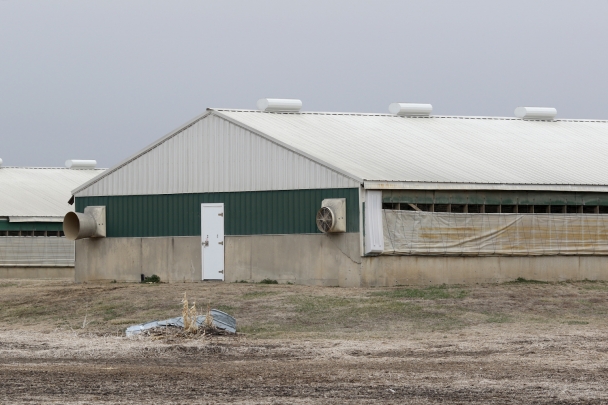Minnesota’s Actions Foreshadow Potential Farm Regulations for Iowa

An animal confinement in northwest Iowa. (Photo by Jared Strong/Iowa Capital Dispatch)
Environmental groups recently asked the federal government to intervene in northeast Iowa, where ag pollution is believed to have contaminated scads of private wells with unhealthy concentrations of nitrate.
Their petition mirrors one that sought the same help last year for southeast Minnesota, which has the same porous topography that makes its groundwater more prone to contamination from the surface.
That request prompted the U.S. Environmental Protection Agency to direct Minnesota to analyze the scope of the problem, provide clean drinking water to affected residents and develop longer-term plans to prevent the contamination.
It’s likely the EPA will give the same direction to Iowa, said Alicia Vasto, water program director for the Iowa Environmental Council, one of the groups that petitioned.
“It is the same geologic formation — a lot of the issues are the same,” Vasto said. “High concentrations of industrial agriculture, intensive cropping systems and livestock facilities. The same risks to drinking water.”
Iowa funds a program that tests private wells at their owners’ request for nitrate and bacteria, and those tests have shown widespread contamination in the area. Notably, nearly a quarter of those tests in Delaware County from 2015 to 2020 had nitrate concentrations that exceeded 10 milligrams per liter, which is a safety threshold to which public water supplies must adhere.
High concentrations in water can acutely affect infants, and studies have linked them to cancers in adults.
State officials in Iowa have been reticent about the petition and what they might do in response. A spokesperson for Gov. Kim Reynolds did not respond to a request to comment for this article.
The Iowa Department of Natural Resources, which oversees livestock operations and manure management, declined to comment about the petition.
A spokesperson for the Iowa Department of Agriculture and Land Stewardship did not directly address the petition but said the department’s efforts to spur farmers to voluntarily implement conservation practices has accelerated in recent years.
What’s happened in Minnesota
The EPA directed Minnesota to take action in November, about six months after it received the petition regarding that state.
Minnesota has said it will — among other actions — adapt its voluntary suggestions and regulatory requirements for livestock operations and the spreading of manure and commercial fertilizers on fields.
That includes potential changes to its feedlot rules that govern manure handling and how much of and where the manure can be spread. It also might include new oversight of smaller feedlot operations.
“They’re taking this seriously,” said Dani Replogle, an attorney for Food & Water Watch, which joined the EPA petitions concerning Iowa, Minnesota and other states. “They are gearing up to do a regulatory overhaul for the feedlot regulations, and that’s what we would like to see happen in Iowa.”
Minnesota had already, in recent years, sought to protect groundwater in sensitive areas that range beyond its southeast region. Minnesota forbids the fall application of nitrogen fertilizer where there are coarse textured soils, shallow bedrock or karst geology, which is a feature of northeast Iowa.
Those fall applications increase the potential for groundwater pollution because the fertilizer is in soil for longer periods of time when crops aren’t growing.
Minnesota also can require farmers to take steps to curb groundwater contamination in certain areas.
Iowa’s approach to agricultural regulations has tended toward loosening them while encouraging farmers to voluntarily reduce their pollution.
A bill that received subcommittee support in the Iowa Senate this year would have allowed feedlots to dispose of manure prior to state approval, even if state regulators rejected their disposal plans, pending an appeal of the rejections.
Another bill would have curtailed anonymous complaints to the Iowa Department of Natural Resources about manure violations. It also failed to advance.
And the DNR recently reversed course on a proposed rule change that would have required better barriers between manure basins and bedrock in karst landscapes. Last week the DNR’s Environmental Protection Commission approved feedlot rules that did not include the provision, and the Iowa Environmental Council announced the EPA petition shortly thereafter.
What the petition seeks
The petition concerning northeast Iowa asks the EPA to use its emergency authority granted by the Safe Drinking Water Act “to urgently address the imminent and substantial endangerment to public health within the karst region of Iowa caused by ongoing and increasing nitrate contamination.”
It alleges that Iowa’s attempts in recent decades to reduce farm pollution have failed.
The state has used its Nutrient Reduction Strategy to encourage voluntary actions by farmers to prevent their fertilizers from leeching into the state’s waterways. Stream monitoring has yet to show significant progress in reducing nitrate and phosphorus contamination since the strategy’s inception in 2014.
“It has been an abysmal failure,” said Michael Schmidt, an attorney for the Iowa Environmental Council. “The fact that Minnesota is having to do more — even though it already has more regulation, more oversight of these sources — means that Iowa will have to take even bigger steps to address the pollution problems here.”
The answer: state-mandated restrictions on the amount of fertilizer than can be applied to crop fields, with special rules for karst landscape, said David Cwiertny, director of the Center for Health Effects of Environmental Contamination at the University of Iowa.
“It can’t be voluntary. It can’t be suggested,” he said. “What will get us improvement — and I know people don’t like to talk about it — but it’s regulations. And regulations work.”
It’s unclear when the EPA might direct Iowa to address the drinking water contamination.
©Copyright 2024, Iowa Capital Dispatch. Published under Creative Commons license CC BY-NC-ND 4.0. Read more at iowacapitaldispatch.com.
Category:
The Eagle Grove Eagle
The Eagle Grove Eagle
P.O. Box 6
304 West Broadway
Eagle Grove, IA 50533
Phone: 1-515-448-4745
FAX: 1-515-448-3182
Email: news@eaglegroveeagle.com
Mid-America Publishing
This newspaper is part of the Mid-America Publishing Family. Please visit www.midampublishing.com for more information.